Home clothes for women should be practical and comfortable, hide flaws and at the same time be beautiful. Bathrobes do an excellent job with these goals, allowing a woman to relax, being at home among her beloved people and things, in cozy and comfortable clothes.
Types and styles of women's dressing gowns
There are few basic styles of women's dressing gowns. This is due to the requirements for home clothes - convenience and comfort. To diversify basic styles, use buttons, zippers, lace, ribbons, ruffles, pockets, hoods and embroidery.
Dressing gown with a wrap and a belt. This model is sewn from expensive and budget, thick and thin fabrics, depending on the purpose.
Kimono. This style is characterized by a loose fit and comfortable wearing. The sleeves of such models of robes are usually wide, in the classic version expanding towards the wrist.
Bathrobe with a zipper. Products with a zipper are usually sewn from soft, stretchy fabrics with a spacious cut.
With buttons. Dressing gowns with buttons can be fitted, straight and flared silhouette, with or without a belt, with a round or v-shaped neckline. There are many variations for a button-down robe, both for cut and decor.
Bathrobe selection criteria
A woman's home life is filled with different events. Therefore, you should have several robes in your wardrobe.
Dressing gowns are:
- Lightweight and warm. It is advisable to have a separate robe for each season. Since it will be chilly in summer clothes in winter, and hot in a warm robe in summer. In addition, it is inconvenient to clean the house in clothes made of warm thick fabrics.
- Casual, smart, and "for special occasions." There should be at least two dressing gowns for daily wear in order to be able to wash used clothes. Casual robes are usually chosen for comfortable, easy-to-move, plain fabrics so as not to be afraid to get dirty while doing housework.
Smart home clothes are suitable for days off from housework, when this time can be spent on rest.
On "special occasions" you want to look doubly attractive. Therefore, robes are chosen from a higher price category, sewn using beautiful fabrics with a spectacular cut. Such models are often made from impractical fabrics that require careful wear and subsequent care.
Peignoirs
Peignoirs are usually worn on three occasions: when they are getting ready to go to bed and put on in the morning as soon as they get out of bed. The third case is romantic dates. The fabrics for this type of clothing are selected thin and flowing. Models for daily use usually have a minimum of decor.
Various ruffles and laces are used for products intended for romantic evenings. In this case, it is better to give preference to bright colors from red to burgundy, as well as shades of dark blue. Peignoirs come in different lengths.
Models with a floor length or below the ankle are suitable for wearing at home on weekends, when there is no need to run somewhere, but you just want to spend time quietly and calmly. The classic length of the negligee is just above the knees. Peignoirs can beautify women of different sizes.
Long models are suitable for tall women. If you have a waist, you can emphasize it with a belt. If you need to hide large hips, you should choose loose silhouettes with a flowing bottom. Small breasts will be "strengthened" by ruffles and bows on the robe.
Wrap-around robes
Women's home dressing gowns with a smell are the most popular model. The convenience of such robes was appreciated by many women. Wraparound clothing can be easily and quickly removed and put on due to lack of buttons or zippers. It can be thrown over a nightgown or pajamas if you need to leave the bedroom for a while.
Usually such models are sewn loose, so they are comfortable and cozy. The wraparound model is the best fit for bathrobes, as if wrapped in warm fabric. Robes can be of different lengths depending on the woman's preference. Summer models are sewn from light fabrics with short sleeves.
Warm, soft fabrics are suitable for dressing gowns for the cold season.
Hooded
The function of the hood of a dressing gown is not always clear. When robes first appeared in the Middle East, the purpose of the hood was to cover the head and face from the roasting sun. These days there is no such need, but the hoods remain.
They are mainly included in the bathrobe models. The fabric of these robes is highly absorbent. therefore Throwing a hood over your head can dry your hair faster, and also hide them from possible drafts. In other cases, the hood is rather decorative.
Dressy with embroidery
Embroidery on a robe is another decor option along with ruffles or lace. For example, lace will look out of place on a thick fabric of a bathrobe, and machine or hand embroidery will look beautiful. Dressing gowns decorated with embroidery can indicate the bright individuality of the hostess, if the embroidery is created independently or to order according to your own sketch.
These robes can be presented as a gift. The gift will become not only useful, but also beautiful.
Lightweight and warm robes
A woman's wardrobe should have different robes depending on the season and the purpose of its use. Light robes are worn in warm weather. Their length depends on the taste of the hostess and the characteristics of the figure. They are often sewn with short or cropped sleeves.
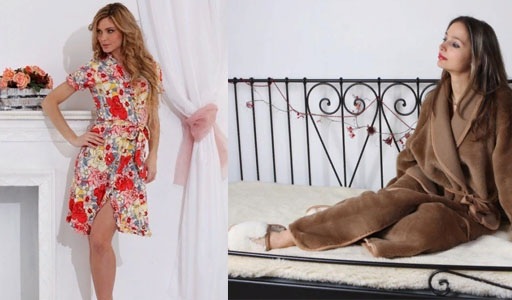
Also, lightweight loose robes with a length from the knee and above are worn during household chores. Bathrobes made of warm fabrics will keep you warm in the cold season. Bathrobes are also sewn warm, even for the summer time to protect a heated body from colds.
What is the best material for the robe?
Women's home dressing gowns must ensure the fulfillment of several conditions of the hostess - to decorate a woman, be comfortable, and also fit in size and style. It is ideal for different occasions to have gowns of different materials.So, products made of terry are suitable as a bathhouse. Choose warm and soft fabrics.
Fleece, terry cloth and flannel will provide the necessary comfort in winter. Silk, satin, cotton - will not let you overheat in summer. For romantic occasions, silk or satin is suitable.
Synthetics
Synthetic fabrics and products made from them have both positive and negative qualities that should be considered before making a purchase.
Of the pros:
- Low price.
- Synthetic clothing looks good. It is easier to give it the desired color, especially when it comes to bright colors.
- Increases the service life of the garment.
Cons:
- Synthetic fabric is waterproof and breathable. This is good quality if you want to sew a windbreaker that protects from wind and rain. But for a dressing gown, these properties of the material will not allow the item to be used after a shower. It will be cold in winter and hot in summer.
- Electrifies. According to the latest data from doctors, with regular wearing of synthetic clothing, the ability to electrify can harm the cardiovascular system and affect the development of various neuroses.
Synthetic clothing, especially home clothing, is allergenic. Moreover, over time, allergies can develop in people who have not previously suffered from it.
For the production of dressing gowns, such artificial materials as fleece, microfiber and polyester are usually used. Women's home dressing gowns made of fleece are suitable for the winter season. They are soft, durable, easy to wash and dry quickly.
Microfiber homewear is also a good inexpensive option for the winter. Microfiber does not allow moisture to pass through at all, so it is not recommended to put on a bathrobe after a shower. Polyester is often used for sewing gowns. The fabric is durable, it retains a presentable look for a long time and does not wrinkle.
To make the bathrobe less electrified, an antistatic agent should be added to the water during washing.
How to choose the right synthetic robe:
- When choosing a robe made of synthetic material, you should check if the product has an unpleasant smell. This smell may indicate a low quality of dyeing, or a violation of the dyeing technology. If there is a smell, then it is better to refuse the purchase, since usually such smells do not pass even after washing.
- Preference should be given to gowns where the label indicates a synthetic content of no more than 70%.
- It must be remembered that robes made of synthetic materials are not suitable for hot weather and are not used as bath robes.
Natural fabrics
Women's dressing gowns can be made from completely natural materials, from artificial materials, but created from natural ingredients, or from natural materials with a slight addition of synthetics.
Bamboo fiber Is a man-made material made from bamboo wood. Dressing gowns made of such fabric have many valuable qualities: they do not cause allergies, are strong, durable, do not wrinkle or lose their shape, they are good for moisture and air.
The disadvantage is the high price.
Cotton Is the most commonly used material for sewing gowns. It is natural and provides good moisture absorption. Cotton products are lightweight.
However, cotton bathrobes wrinkle a lot, shrink during washing and may shed.
Various fabrics are made from cotton.
For the manufacture of robes use:
- Mahru... Robes made of this material are all-season, perfectly regulate the heat exchange between the body and the external environment.
- Chintz... Fabric is cheap to manufacture, so chintz products are available to many.
- Calico... Thicker fabric than chintz. Coarse calico clothes are durable.
- Satin... A satin robe, unlike other cotton fabrics, has a silky sheen. It is more durable and more durable. The price for such products is higher.
- Flannel... Dressing gowns are made from flannel for the cold season, as the material is warm and soft. However, over time, the surface of the flannel robe rolls down and loses its appearance.
silk robe - natural and pleasant to the touch. It has a cooling effect in hot weather. However, the sliding surface of silk is not comfortable or practical for daily wear.
Bathrobes
The terry robe provides the hostess with comfort and coziness. It is purchased as body-pleasant clothing that is worn after water procedures, or for daily wear at home. The acquisition of a terry dressing gown should be taken seriously, since a wrong choice can completely deprive a thing of the qualities required of it - warming and moisture-absorbing.
Criteria for the quality of the gown:
- Mahra.
The general name of the fabric from which the dressing gowns are sewn is makhra. In fact, this name hides different types of fabrics. Classic terry is cotton. But pure cotton after several washes will coarse and the robe will lose its softness. But the material is hypoallergenic and perfectly breathable.
Often, other materials are added to cotton to give the thing additional properties. Synthetic fibers keep the bristles soft. A product made from such terry is light and weakly wrinkled. The addition of bamboo to cotton makes the terry soft, silky fabric that has a massage effect when rubbed against the skin.
- The density of the fabric.
Terry density means the weight of the material, measured in grams, divided by the area of 1 sq. M. A product made of terry with a density of up to 360 g / m2 is of low quality. It is thin, does not hold its shape well, the loops of the terry cloth usually open easily, while lint-free bald spots form on the fabric. The cost of dressing gowns made of such terry is low.
With a fabric density of 360-400 g / m2, the dressing gown is warm with good moisture absorption. This is the ideal fabric if you need to choose an inexpensive but high quality robe. When the density of terry is above 400 g / m2, the cost of the robe increases significantly.
These are high quality robes, made of cotton terry, or with the addition of natural fibers, such as bamboo.
- Fabric color.
When purchasing a terry robe or terry cloth for sewing, you should evaluate the coloring of the terry cloth from the seamy side and front side. The color difference should be minimal. A large difference indicates that the fabric is poorly dyed and sheds when washed.
Over time, even high-quality robes can lose their brightness. This is especially noticeable on dark colors - blue, green, burgundy. Therefore, to make the robe last longer, it is better to buy things of light shades - white, yellow, pink.
- Style.
If the robe is planned to be used only after bath procedures, then long models will do, without buttons and other fasteners with a belt at the waist. In other cases, the style can be any. When buying a gown, you should carefully examine the seams of the product. In order not to chafe the skin, they must be hidden, or properly processed.
Silk
Silk robes are able to decorate a woman with any figure and make her image depending on the situation: smart, sexy or expensive.
Among the most relevant models are:
- Kimono... This model has wide, elongated sleeves. The length of such a robe can vary, but often these are long models.
- Wrap-around robe... It is a lightweight, comfortable model that suits any size and age. For owners of slender legs, shortened models are suitable. The high cut on the side visually lengthens the figure, giving it a feminine touch. Guipure and lace add a luxurious look.
Natural silk is an expensive material.
If the price of a robe seems affordable, you should check the label with the composition of the material. Under the guise of a silk robe, products made from artificial silk, or natural silk with the addition of synthetic fibers can be sold. All this reduces the price of the product.
Video selection of silk robes for all occasions:
You can also check the material for naturalness by sliding the back of your hand over it. Real silk is cool. But this method is subjective and only suitable for hot weather. Stores with quality clothing may suggest setting fire to a sample of the material from which the robe is made. Silk smells like wool when burning.
It is better to wash a silk robe with your hands; with machine washing, the temperature should not be higher than 20 degrees, while the product should only be wrung out by hand.
Velor options
Velor dressing gowns have earned popularity among women due to their comfort in wearing and a wide range of model options. The fabric consists of villi that fit tightly to each other, but they are shorter than that of terry. The basis is usually a knitted fabric. From this velor robes are comfortable for any household work.
Velor fabric is usually made from cotton threads. There are also fabrics with the addition of synthetic fibers.Synthetics allow you to maintain the appearance of the product for a longer time, while the ability of the fabric to have good air exchange is lost.
Velor bathrobes are suitable for women of various sizes. Models with a length below the knee and a spacious cut help to hide the fullness.
Velor is a versatile fabric that allows designers to come up with new spectacular details - inserts from other materials. Lace looks especially impressive. Models with zippers are especially popular, since such gowns are easy to take off and put on, they do not open at the wrong time and look good on any figure.
Women's dressing gowns for the house are sewn from different types of velor:
- Plain smooth velor is ideal for any type of dressing gown, including a bathrobe. Manufacturers offer a wide selection of different models of smooth velor robes.
- Velor with embossing in the form of various patterns or patterns will add originality to even the simplest models.
- Velor with alternating areas where the pile is smoothed and where it is not has a higher density and is suitable for the cold season.
Velor, thanks to its texture, gives the models an expensive look. The knitted base allows the products not to wrinkle and keep a new look for a long time. Velor dressing gowns keep the shape of the product well and have high wear resistance. The only thing that can darken the mood of the hostess of a velor robe is dust and other lint that cling to the fabric.
But they are easy to clean with special brushes, in addition, velor is well erased and retains its original color for a long time.
Which color is best?
The choice of color for home clothes is usually dictated by the taste of the hostess.
Nevertheless, there are a number of rules that it is advisable to adhere to when choosing a bathrobe:
- The dressing gown is associated with home, tenderness and comfort, so the best option is pastel colors. You can even choose white, but it looks boring and it is better to leave it for trips to the sauna, spa or hotels.
- Yellow color - speaks of the optimism of the hostess and is able to cheer upbut it doesn't suit everyone. You should choose your color from a wide palette of yellow shades. Any of them will do for brunettes. And blondes can blend in with clothes if they choose the wrong yellow.
- Red is more suitable for brunettes.
- Women with blonde hair will be adorned with blue and shades of blue.
- With the right shade of green, you can find the perfect color solution for all women.
- Black is versatile.
- Gray - gives a woman elegance, it is great for negligee.
- The floral pattern should be chosen in calm, delicate shades.
- The stripes on the dressing gown running vertically - slim and lengthen the figure.
Horizontal - are able to give a few extra pounds.
What styles are suitable for obese women?
Women in the PLUS size should be careful not only in their choice of casual streetwear, but also their homewear. An unsuccessful cut can ruin the image, highlighting the flaws, or simply be uncomfortable to wear. For women of large sizes, models with a zipper, wrap or tunic style are suitable.
- Zippered robe comfortable and practical. The floors of the clothes do not open. It fastens and unfastens easily. It is recommended to choose a product with a knee length or lower.
- Wrap models this is the classic version. It is convenient in that the belt can be adjusted in case of gaining or losing weight, and also, if desired, to emphasize the waist with it.
- Tunic robe suitable for women who prefer freedom of movement and want to reduce the emphasis on the features of the figure.
How to sew a bathrobe for home with your own hands?
Women's dressing gowns are easy to sew on your own. At the same time, the craftswoman herself can choose any style and fabric that she likes, which is not available when buying a dressing gown in a store.
Simple pattern of a kimono robe:
The product will require silk, satin or any other flowing fabric.
You need to carve out 6 parts:
| the name of detail | Qty |
| Back | 1 |
| Shelf | 2 |
| Sleeves | 2 |
| Belt | 1 |
The width of the back piece should be 1.5 times wider than the back. Also, this size, divided in half, will correspond to the width of each shelf. To build the bevel of the neck, you need to set aside 10 cm from the side of the shelf adjacent to the neck. The second point is at the waist.
For a bevel, these two points must be connected. 15 cm above the waist will be the bottom point of the sleeve to be sewn. To determine the required belt length, measure your waist and increase the indicated measurement by 40 cm.
Sewing:
- 2 shelves need to be sewn along the shoulder seam to the back.
- Next, both sleeves should be sewn.
- Last but not least, the details of the shelves and backs are sewn along the side seam.
- To sew a belt, fold the part in half and carefully sew the belt.
The comfort of a woman depends on the right choice of a bathrobe for the home. Therefore, it is important to have different robes in the wardrobe for different situations. You don't have to buy so many home clothes. There are many simple patterns for home use on the Internet.
Author: Vorobieva Nadezhda
Article design:E. Chaikina
Useful video clip about women's dressing gown
Video on how to quickly sew a full-length dressing gown for everyday wear and for an evening out:

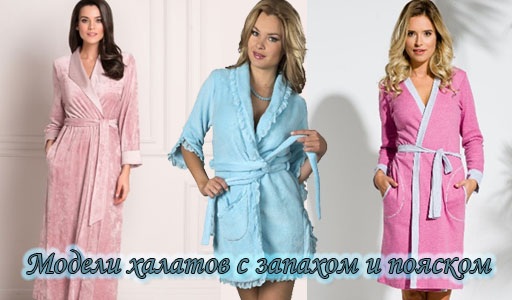
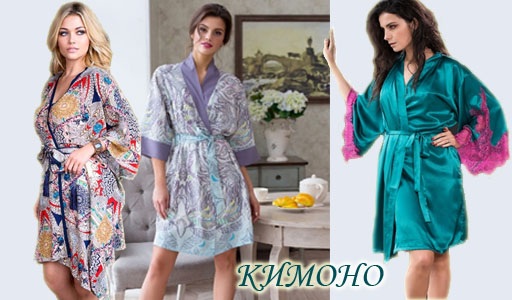
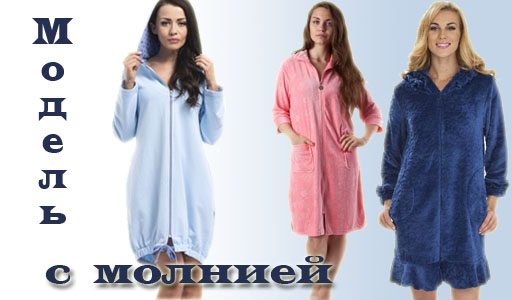
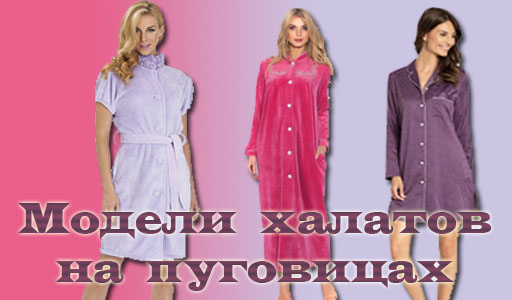
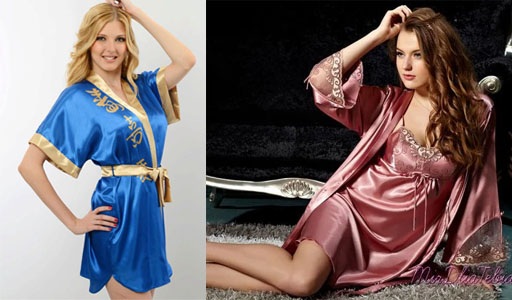
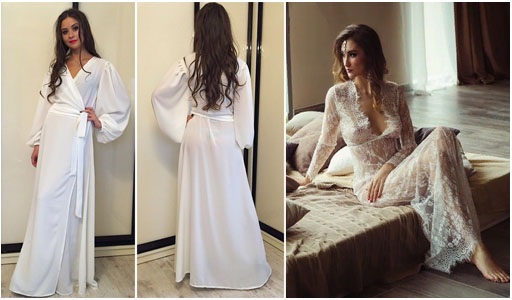
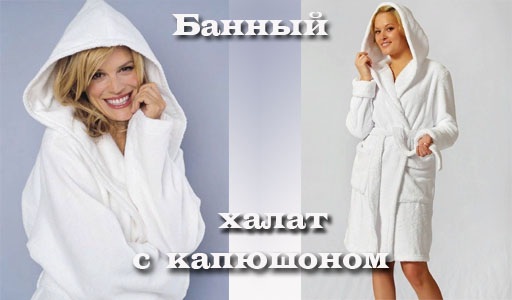
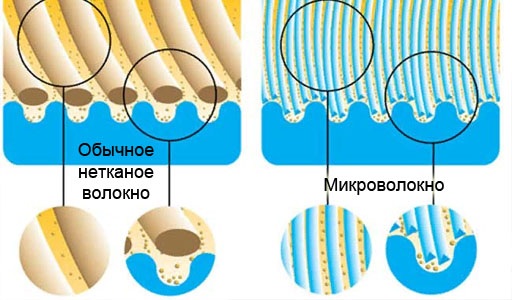

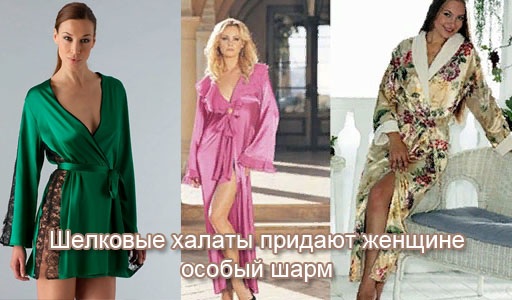
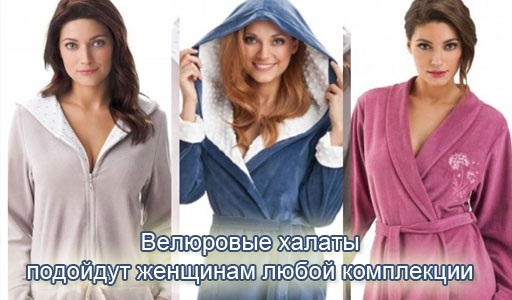
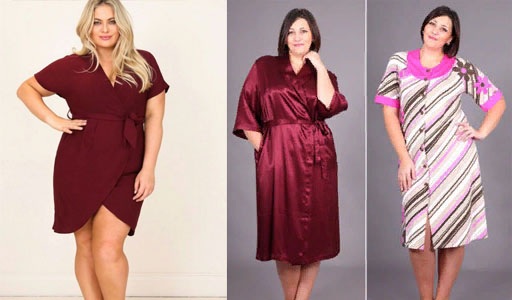
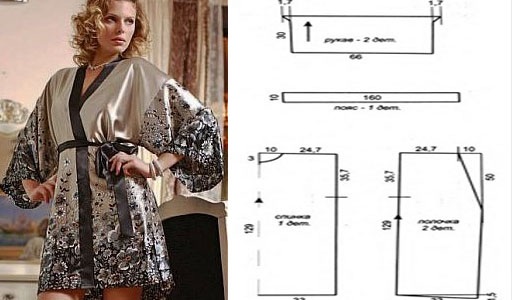
I had a robe made of artificial silk, and so, honestly, it was indestructible - 6 years of socks and looked very much even nothing. I experienced all the calico and terry cloth. But I don’t know from natural silk, I have never been, I wonder how long it is tenacious?